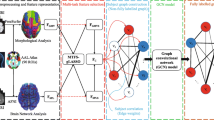Abstract
Mild cognitive impairment (MCI) is an early stage of Alzheimer’s disease (AD), which is also the best time for treatment. However, existing methods only consider neuroimaging features learned from group relationships instead of the subjects’ individual features. Such methods ignore demographic relationships (i.e., non-image information). In this paper, we propose a novel method based on multi-scale graph convolutional network (MS-GCN) via inception module, which combines image and non-image information for MCI detection. Specifically, since the brain has the characteristics of high-order interactions, we first analyze the dynamic high-order features of resting functional magnetic resonance imaging (rs-fMRI) time series and construct a dynamic high-order brain functional connectivity network (DH-FCN). To get more effective features and further improve the detection performance, we extract the local weighted clustering coefficients from the original DH-FCN. Then, gender and age information are combined with the neuroimaging data to build a graph. Finally, we perform the detection using the MS-GCN, and validate the proposed method on the Alzheimer’s Disease Neuroimaging Initiative (ADNI) dataset. The experimental results demonstrate that our proposed method can achieve remarkable MCI detection performance.
This work was supported partly by National Natural Science Foundation of China (Nos. 61871274, 61801305 and 81571758), National Natural Science Foundation of Guangdong Province (No. 2017A030313377), Guangdong Pearl River Talents Plan (2016ZT06S220), Shenzhen Peacock Plan (Nos. KQTD2016053112051497 and KQTD2015033016 104926), and Shenzhen Key Basic Research Project (Nos. JCYJ2017 0413152804728, JCYJ20180507184647636, JCYJ20170818142347251 and JCYJ20170818094109846).
Access this chapter
Tax calculation will be finalised at checkout
Purchases are for personal use only
Similar content being viewed by others
References
Alzheimer’s Association: 2018 Alzheimer’s disease facts and figures. Alzheimers Dement. 14(3), 367–425 (2018)
Petersen, R.C., et al.: Current concepts in mild cognitive impairment. Arch. Neurol. 58(12), 1985–1992 (2001)
Huettel, S.A., Song, A.W., McCarthy, G.: Sinauer Associates Sunderland. Functional Magnetic Resonance Imaging, MA (2004)
Bullmore, E., Sporns, O.: Complex brain networks: graph theoretical analysis of structural and functional systems. Nat. Rev. Neurosci. 10(3), 186 (2009)
Wee, C.-Y., Yap, P.-T., Zhang, D., Wang, L., Shen, D.: Group-constrained sparse fMRI connectivity modeling for mild cognitive impairment identification. Brain Struct. Funct. 219(2), 641–656 (2014)
Hart, B., et al.: A longitudinal model for functional connectivity networks using resting-state fMRI. NeuroImage 178, 687–701 (2018)
Parisot, S., et al.: Disease prediction using graph convolutional networks: application to autism spectrum disorder and Alzheimer’s disease. Med. Image Anal. 48, 117–130 (2018)
Ktena, S.I., et al.: Metric learning with spectral graph convolutions on brain connectivity networks. NeuroImage 169, 431–442 (2018)
Kazi, A., et al.: InceptionGCN: receptive field aware graph convolutional network for disease prediction. In: Chung, A.C.S., Gee, J.C., Yushkevich, P.A., Bao, S. (eds.) IPMI 2019. LNCS, vol. 11492, pp. 73–85. Springer, Cham (2019). https://doi.org/10.1007/978-3-030-20351-1_6
Wang, J., Wang, X., Xia, M., Liao, X., Evans, A., He, Y.: GRETNA: a graph theoretical network analysis toolbox for imaging connectomics. Front. Hum. Neurosci. 9, 386 (2015)
Tzourio-Mazoyer, N., et al.: Automated anatomical labeling of activations in SPM using a macroscopic anatomical parcellation of the MNI MRI single-subject brain. NeuroImage 15(1), 273–289 (2002)
Author information
Authors and Affiliations
Corresponding author
Editor information
Editors and Affiliations
Rights and permissions
Copyright information
© 2019 Springer Nature Switzerland AG
About this paper
Cite this paper
Yu, S., Yue, G., Elazab, A., Song, X., Wang, T., Lei, B. (2019). Multi-scale Graph Convolutional Network for Mild Cognitive Impairment Detection. In: Zhang, D., Zhou, L., Jie, B., Liu, M. (eds) Graph Learning in Medical Imaging. GLMI 2019. Lecture Notes in Computer Science(), vol 11849. Springer, Cham. https://doi.org/10.1007/978-3-030-35817-4_10
Download citation
DOI: https://doi.org/10.1007/978-3-030-35817-4_10
Published:
Publisher Name: Springer, Cham
Print ISBN: 978-3-030-35816-7
Online ISBN: 978-3-030-35817-4
eBook Packages: Computer ScienceComputer Science (R0)





